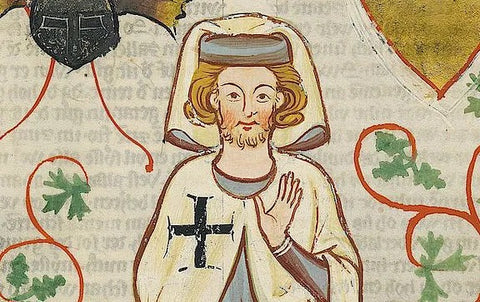In memory of the 613th anniversary of the Battle of Grunwald we thought we'd take a closer look at our Grunwald Sword. The Battle of Grunwald was one of the largest battles in medieval Europe when the Kingdom of Poland and the Grand Duchy of Lithuania defeated the knights of the Teutonic Order, accelerating the decline of the monastic state of the Teutonic Order.

The Teutonic Order were, like the Hospitallers and Templars, a crusading order of knights recognized by the Pope with a mission to help Christian pilgrims and to fight against anyone who was determined to be an enemy of Christendom. This included crusades in the Holy Land against the Muslims, and in the Baltic region against the pagan societies that were still holding on.

A knight of theTeutonic Order portrayed in the Codex Manesse, UB Heidelberg, Cod. Pal. germ. 848, fol. 264r: Der Tannhäuser
Our Grunwald sword is based on original piece produced circa 1350-1425, that is now housed in private collection. The sword has an overall length of just under 37" with a weight of 2.5 pounds. This beautiful sword has the broad blade, down curved guard and wheel pommel that were popular in the age of mail and birth of plate armor. An Oakeshott Type XIIIb blade has a narrow fuller that runs just over halfway down the blade. This single handed sword has an excellent heft for cutting blows with a balance point approximately four and a quarter inches in front of the guard. The sword weighs just under two and a half pounds.

The Grunwald Sword by Arms and Armor.
The asymmetrical wheel pommel and down swept flaring guard is one of the most enduring styles of hilt design, probably more popular today than in the day of its forging. The hilt components are steel with a leather covered wooden grip in brown or black, as you prefer. Examples appear early in the middle ages but continue to be made in different forms right through to the Renaissance. The flaring arms of this guard are particularly appealing and create a classic medieval sword to add to your armory.

The Grunwald Sword by Arms and Armor.
Said to have its origins in Eastern Europe this knightly sword comes from the period of the Northern Crusades. This tumultuous time was fraught with ethnic and religious wars as the Christian rulers of Denmark, Sweden and the Germanic Military orders tried to expand into the southern and eastern Baltic regions.

Note the details such as the risers on the grip, the asymmetrical disc pommel, and the fullered blade.
Generations of warfare ensued and continued even past the last great battle of the era in 1410. The Battle of Grunwald, occurred on July 15th in 1410, just south of the modern town of Ostroda in Poland. This clash of the Teutonic Knights against an alliance of Poles, Lithuanians, and contingents of Tatar, Moldovan and Czech troops is one of the largest battles in Medieval Europe. We have chosen to title our reproduction after this famous struggle. While details of this engagement are slim each nationality involved has used it as a call to arms when they have felt threatened over the last six centuries

Nathan Clough, Ph.D. is Vice President of Arms and Armor and a member of the governing board of The Oakeshott Institute. He is a historical martial artist and a former university professor of cultural geography. He has given presentations on historical arms at events including Longpoint and Combatcon, and presented scholarly papers at, among others, The International Congress on Medieval Studies.
Craig Johnson is the Production Manager of Arms and Armor and Secretary of The Oakeshott Institute. He has taught and published on the history of arms, armor and western martial arts for over 30 years. He has lectured at several schools and Universities, WMAW, HEMAC, 4W, and ICMS at Kalamazoo. His experiences include iron smelting, jousting, theatrical combat instruction and choreography, historical research, European martial arts and crafting weapons and armor since 1985
